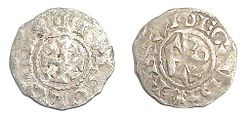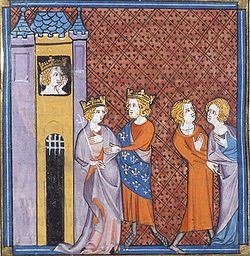| Fulk IV | |
|---|---|
 | |
| Count of Anjou | |
| Reign | 1068 – 14 April 1109 |
| Predecessor | Geoffrey III |
| Successor | Fulk V |
| Joint rule | Geoffrey IV, Count of Anjou (until 1106) |
| Born | 1043 |
| Died | 14 April 1109 |
| Spouses |
|
| Issue | Ermengarde, Duchess of Brittany Geoffrey IV, Count of Anjou Fulk, King of Jerusalem |
| House | House of Anjou |
| Father | Geoffrey II, Count of Gâtinais |
| Mother | Ermengarde of Anjou |
Fulk IV (French: Foulques IV d'Anjou; 1043 – 14 April 1109), better known as Fulk le Réchin (Latin: Fulco Rechin), was the count of Anjou from around 1068 until his death. He was noted to be "a man with many reprehensible, even scandalous, habits" by Orderic Vitalis, who particularly objected to his many women and his influential footwear, claiming he popularized the pigaches that eventually became the poulaine, the medieval long-toed shoe.
Name
Fulk was the usual name of the medieval counts of Anjou. It is the English form of the same Germanic masculine given name latinized as Fulco in contemporary accounts and written Foulques in modern French. They are all cognate with the word folk ("people, kin").
Réchin, the epithet by which he is usually known, has no certain translation. Philologists have made numerous and varied suggestions, most but not all negative, including "the Quarreler", "the Rude", "the Sullen", "the Surly", and "the Heroic".
Life
Early life
Fulk, born in 1043, was the younger son of Geoffrey II, Count of Gâtinais (sometimes known as Aubri), and Ermengarde of Anjou. Ermengarde was a daughter of Fulk the Black, an earlier count of Anjou, and the sister of Geoffrey Martel who inherited Anjou upon his father's death.
Count of Anjou

Geoffrey Martel died without direct heirs, leaving Anjou to his nephew Geoffrey III, Fulk's older brother. Some sources declare that his rule was incompetent and Fulk contested the succession, capturing Geoffrey in 1067. Under pressure from the church, he released Geoffrey but the two brothers soon fell to fighting again. The next year Geoffrey was again imprisoned by Fulk, this time for good. Fulk then ruled Anjou from 1068 until his death.
Substantial territory was lost to Angevin control due to the difficulties resulting from Geoffrey's poor rule and the brothers' warring. Saintonge was lost, and Fulk had to give the Gâtinais to Philip I of France to placate the king upon his victory. Much of Fulk's rule was devoted to regaining control over this territory and to a complex struggle with Normandy for influence in Maine and Brittany.
At some point before 1106, Fulk made a major gift to the Fontevraud Abbey.
Wives

There are conflicting accounts of Fulk's life, including some who pointedly condemned him as "a man with many reprehensible, even scandalous, habits". The clerics of his time particularly objected to his sexual promiscuity or deviance, which included marrying as many as five times, although the exact number of lawful wives, divorces, and repudiations is disputed.
Providing all the claimed formal marriages, he was said to have first wed Hildegarde of Beaugency in 1067. Ermengarde of Anjou, their daughter, later married Alan IV, duke of Brittany. Hildegarde was said to have died c. 1070. Fulk was then said to have married Ermengarde of Bourbon, daughter of its lord Archambaud IV the Strong. Geoffrey IV Martel, their son, ruled jointly with Fulk for some time but died in 1106. Some of the sources state Fulk repudiated Ermengarde in 1075 on the basis of consanguinity. Around 1076, Fulk then wed Orengarde of Châtelaillon, the daughter of its lord Isambert or Isembard. He is said to have repudiated her in 1080, again on grounds of consanguinity. He was then said to have married a daughter of Walter I, Count of Brienne by 1080. He was said to have divorced this woman, whose name was not recorded in surviving accounts, in 1087.
Most scandalously, he was said to have married Bertrade, daughter of Simon I, lord of Montfort, in 1089. He extorted Robert Curthose for support of the marriage in exchange for his assistance with rebel Manceaux, which ultimately required Robert to restore the lands of Ralph the Asshead to Bertrade's guardian William of Évreux. Bertrade bore him Fulk V, who later became count of Anjou and king of the Crusader realm of Jerusalem, before 1092, when she either abandoned Fulk in favor of King Philip I or was abducted by the king. (Accounts vary.) Apparently bigamously, she married the king and became queen of France on 15 May 1092. She was said to have fully reconciled Fulk with the king and the situation.
Death
Fulk died on 14 April 1109 leaving the restoration of the county of Anjou as it had been under Geoffrey III to his successors.
Works
A Latin history of Anjou and its rulers—surviving only in part and now known as A Partial History of Anjou (Fragmentum Historiae Andegavensis)—are said to have been written by Fulk in 1096, although both the authorship and authenticity of the work are disputed. The first part of the work describing Fulk's ancestry and some of his ancestor's deeds is extant. A second part which would have dealt with Fulk's own times—if it were ever written—has been lost. If he wrote it, it would have been one of the first works of history in medieval Europe written by a layman rather than a cleric. Some scholars propose that Fulk may have actually commissioned the work but used scribes to compose it.
Legacy

Amid his other denunciations of Fulk, the English historian Orderic Vitalis blamed him for the invention of pigaches, the pointy-toed "scorpion-tail" shoes, which became fashionable in France and England around this time and later developed into the unwieldy elongated poulaines. Supposedly Fulk began wearing narrow shoes with lengthened toes as a way of hiding his unsightly bunions from his 5th wife Bertrade before she abandoned him in favor of the king. (The fashion historian Ruth Wilcox offers that it may have been a simple adaptation of the Normans' sabatons, which they had extended to a point and turned down in the late 11th century to better hold their stirrups during battle.) In any case, the footwear was considered vain and obscene—if not demonic—and were immensely unpopular with the church leadership of the period. St Anselm banned its use by English clerics at the 1102 Synod of Westminster, the papal legate Robert de Courson banned its use by the faculty of the University of Paris in August 1215, and the Fourth Lateran Council finally banned them for all Catholic clergy the same year.
References
Citations
- ^ Bradbury (1989), p. 27.
- Kroll & Bachrach 1990, p. 3.
- Bachrach (1993), p. 262.
- Bradbury (1989), p. 31.
- Bradbury (1989), p. 32.
- Keats-Rohan (1997), p. 257.
- Dunbabin (2005), p. 189.
- Dunbabin (2005), pp. 189–190.
- Mews (2006), p. 135.
- ^ Chibnall (1973), pp. 186–187.
- Bradbury (1989), p. 36.
- Choffel (1988), p. 152.
- William of Jumieges (1992), p. 260.
- Vaughn (2002), p. 106.
- ^ Mews (2006), p. 132.
- Aird (2008), p. 127–128.
- Webster (2015), p. 90.
- Bradbury (2007), p. 119.
- Barlow (2014), p. 156.
- Dunbabin (2005), p. 190.
- Paul (2007), pp. 20–21.
- Paul (2007), pp. 19–35.
- Aird (2016), p. 196.
- Planché (1876), p. 459.
- Mills (2015), p. 82.
- Wilcox (1948), p. 65.
- Perry (1890), p. 190.
- Robert de Courson (1215).
- Alberigo & al. (1973).
- Dittmar & al. (2021).
Sources
- Aird, William M. (2008), Robert Curthose Duke of Normandy (c. 1050–1134), Woodbridge: Boydell Press.
- Aird, William M. (2016), "Orderic's Secular Rulers and Representations of Personality and Power in the Historia Ecclesiastica", Orderic Vitalis: Life, Works, and Interpretations, Woodbridge: Boydell Press, pp. 189–216.
- Alberigo, J.; et al., eds. (1973), "Concilium Lateranense IV a. 1215" (PDF), Conciliorum Oecumenicorum Decreta (in Latin), pp. 230–271.
- Bachrach, Bernard S. (1993). Fulk Nerra, the Neo-Roman Consul, 987–1040. University of California Press.
- Barlow, Frank (2014). The Feudal Kingdom of England: 1042–1216. Routledge.
- Bradbury, Jim (1989). Harper-Bill, Christopher; Holdsworth, Christopher J.; Nelson, Janet L. (eds.). "Fulk le Rechin and the Origin of the Plantagenets". Studies in Medieval History Presented to R. Allen Brown. The Boydell Press.
- Bradbury, Jim (2007). The Capetians: Kings of France, 987–1328. Hambledon Continuum.
- Choffel, Jacques (1988). Mais Où Sont les Normandes d'Antan (in French). F.Sorlet.
- Dittmar, Jenna M.; et al. (December 2021), "Fancy Shoes and Painful Feet: Hallux Valgus and Fracture Risk in Medieval Cambridge, England", International Journal of Paleopathology, vol. 35, Los Angeles: Paleopathology Association, pp. 90–100, doi:10.1016/j.ijpp.2021.04.012, hdl:2164/17718.
- Dunbabin, Jean (2005). France in the Making, 843–1180 (2nd ed.). Oxford University Press.
- Keats-Rohan, K.S.B. (1997). Family Trees and the Root of Politics: A Prosopography of Britain and France from the Tenth to the Twelfth Century. The Boydell Press.
- Kroll, Jerome; Bachrach, Bernard S. (1990). "Medieval Dynastic Decisions: Evolutionary Biology and Historical Explanation". Journal of Interdisciplinary History. 21 (Jan.). MIT Press: 1–28.3
- Mews, Constant J. (2006). "Negotiating the Boundaries of Gender in Religious Life: Robert of Arbrissel and Hersende, Abelard and Heloise". Viator. 37. CMRS Center for Early Global Studies: 113–148.
- Mills, Robert (2015), Seeing Sodomy in the Middle Ages, Chicago: University of Chicago Press.
- Paul, Nicholas L. (2007). Morillo, Stephen; Korngiebel, Diane (eds.). "The Chronicle of Fulk le Rechin: a Reassessment". The Haskins Society Journal 18: Studies in Medieval History. The Boydell Press.
- Orderic Vitalis (1973), Chibnall, Marjorie (ed.), The Ecclesiastical History..., vol. IV, Oxford: Clarendon Press.
- Perry, George Gresley (1890), A History of the English Church: First Period: From the Planting of the Church in Britain to the Accession of Henry VIII. (596–1509), The Student's English Church History (5th ed.), London: John Murray.
- Planché, James Robinson (1876), A Cyclopaedia of Costume..., London: Chatto & Windus.
- Robert de Courson (1944), "Rules of the University of Paris", in Thorndyke, Lynn (ed.), University Records and Life in the Middle Ages, New York: Columbia University Press, pp. 103–105.
- Vaughn, Sally N. (2002). St. Anselm and the Handmaidens of God: A Study of Anselm's Correspondence with Women. Brepols.
- Webster, Paul (2015). King John and Religion. Boydell Press.
- Wilcox, Ruth Turner (1948), The Mode in Footwear, New York: Charles Scribner's Sons.
- William of Jumieges (1992). The Gesta Normannorum Ducum of William of Jumièges, Orderic Vitalis, and Robert of Torigni. Vol. viii. Clarendon Press.
| Preceded byGeoffrey III | Count of Anjou with Geoffrey IV 1068–1109 |
Succeeded byFulk V |